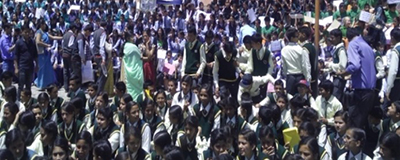Relevance: GS-2: Issues relating to development and management of Social Sector/Services relating to Health, Education, Human Resources; Government policies and interventions for development in various sectors and issues arising out of their design and implementation; Welfare schemes for vulnerable sections of the population by the Centre and States and the performance of these schemes
Key Phrases: Beti Bachao Beti Padhao programme, Girls’ education, learning outcomes, gender-specific programmes, infrastructural gaps.
Why in News?
- A recent study, examined the impact of Beti Bachao Beti Padhao programme on girls’ educational and learning outcomes and found no salutary effect of the BBBP programme.
Context:
- Promotion of girls’ education has been central to policymaking
across the globe, especially in developing countries.
- Girls tend to drop-out early from schools and restrictive gender norms often manifest themselves in early marriage.
- India is no exception to this malaise. Gender disparities in
educational outcomes still persist.
- According to the Census 2011, the effective literacy rate for males was 82.14 per cent whereas the same for females was 65.46 per cent.
- The Global Gender Gap Report (2021) ranked India at 114 out of 156 countries based on educational attainment.
- However, educating women in a developing country generates both
direct and indirect social returns:
- Education empowers women to make better decision about marriage, family planning, etc.,
- Educated mothers pave the way for improved health (reduced infant mortality rates, higher immunisation rates, etc.) and educational outcomes (for example, increased years of schooling) of their children.
Steps by Government:
Against this backdrop, a number of gender-specific programmes have been implemented over the years to close the gaps.
- In 2015, the government launched the flagship programme, Beti Bachao
Beti Padhao (BBBP).
- The key objectives of the programme are to promote girls’ survival and their educational outcome.
- According to the Ministry of Women and Child Welfare, the overall goal of the BBBP scheme is to prevent gender biased sex selective elimination; ensure survival and protection of the girl child; and ensure her education.
- The BBBP programme was implemented in 100 districts mostly having child sex ratio (CSR) below the national average (918 girls per 1,000 boys) in the first phase in 2015 and, subsequently, it was extended to another 61 districts during phase 2 in 2016.
- To this end, a number of States had also introduced female-centric
schemes.
- Conditional cash transfer (example, Apna Beti Apna Dhan in Haryana, Ladli Laxmi Yojana in Madhya Pradesh, Kanyashree in West Bengal),
- Providing free sanitary napkins (example, She Pad scheme in Kerala), and
- State-funded bicycle programme (Mukhyamantri Balika Cycle Yojana in Bihar) are examples of such state-level interventions.
Findings of the Study:
- A recent study examined the impact of BBBP programme on girls’
educational and learning outcomes.
- In order to make a causal inference, it compared gender gaps in outcome variables between districts with and without exposure to the BBBP programme.
- Using data available from nationally representative surveys, the study found that the BBBP programme had no discernible impact on probability of a girl being enrolled in school, girls’ grade completion, and girl-specific educational expenditure.
- With respect to learning outcomes, again it did not find any evidence of statistically significant impact on girls’ reading ability (for example, ability to identify letters, read words, etc.) and math skills (for example, recognise numbers 1-9, doing subtraction, etc.).
- The study conducted qualitative interviews with parents of girl
children to gain a nuanced understanding of female education in India.
- The interviews revealed that while awareness about sending girls to school was generally high, parents faced infrastructural gaps that limit their ability to enrol and sustain the girls in schools.
- Distance to school, availability of safe transport, hygienic toilet facilities in school, and so on, were some of the factors that discouraged parents from continuing their girls in school.
- As per the report of the Parliamentary Committee on Empowerment of
Women (2021), the total budgetary allocation by the Central Government
for the programme during 2015-2019 was to the tune of ₹8.48 billion, of
which, only ₹6.22 billion was released to the States.
- Interestingly, the PSC’s report found that more than 78 per cent of the funds were spent on media advertisements and generating campaign material, but the utilisation in the multi-sectoral interventions have been quite meagre — hovering around only 16 per cent.
- The said report also documented gross underutilisation of funds allocated for the programme by the States.
Conclusion:
- The study suggested that mere gender-based awareness campaigns are not enough to provide solutions to this difficult problem unless suitable policies are undertaken to improve school infrastructure, school-level inputs such as teachers, textbooks, as well as reduced distance for commute to school, safe modes of transport, safe and hygienic toilets and raising awareness to challenge the cultural and social norms.
- This calls for a multi-pronged and multi-sectoral approach to attenuate the existing gender gaps in education in India.
Source: The Hindu BL
Mains Question:
Q. Promotion of girls education is important to empower Women. In this light provide the success and limitation of Beti Bachao Beti Padhao and steps to improve. (250 words).






















